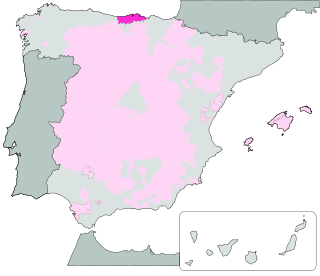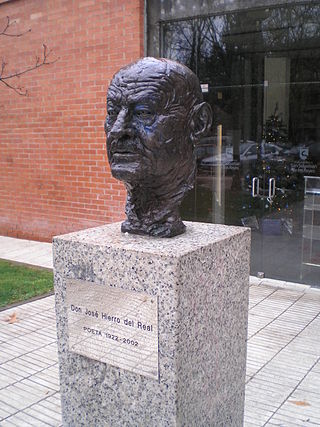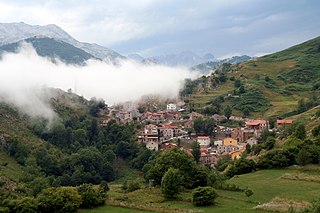
The Pyrenees are a mountain range straddling the border of France and Spain. They extend nearly 500 km (310 mi) from their union with the Cantabrian Mountains to Cap de Creus on the Mediterranean coast, reaching a maximum altitude of 3,404 metres (11,168 ft) at the peak of Aneto.

Cantabria is an autonomous community and province in northern Spain with Santander as its capital city. It is called a comunidad histórica, a historic community, in its current Statute of Autonomy. It is bordered on the east by the Basque autonomous community, on the south by Castile and León, on the west by the Principality of Asturias, and on the north by the Cantabrian Sea, which forms part of the Bay of Biscay.

León is a province of northwestern Spain in the northern part of the Region of León and in the northwestern part of the autonomous community of Castile and León.

The Picos de Europa are a mountain range extending for about 20 km (12 mi), forming part of the Cantabrian Mountains in northern Spain. The range is situated in the Autonomous Communities of Asturias, Cantabria and Castile and León. The highest peak is Torre de Cerredo, at an elevation of 2650 m (8,690 ft).

Nevado de Toluca is a stratovolcano in central Mexico, located about 80 kilometres (50 mi) west of Mexico City near the city of Toluca. It is the fourth highest of Mexico's peaks, after Pico de Orizaba, Popocatépetl and Iztaccíhuatl. The volcano and the area around it is now a national park.

The Picos de Europa National Park is a National Park in the Picos de Europa mountain range, in northern Spain. It is within the boundaries of three autonomous communities, Asturias, Cantabria and Castile and León, which are represented on the body which runs the park. The park is also a popular destination for hikers and trekkers.

Liébana is a comarca of Cantabria (Spain). It covers 575 square kilometres and is located in the far southwest of Cantabria, bordering Asturias, León and Palencia. It is made up of the municipalities of: Cabezón de Liébana, Camaleño, Cillorigo de Liébana, Pesaguero, Potes, Tresviso and Vega de Liébana.

Liébana is a Spanish geographical indication for vino de la tierra wines located in the autonomous region of Cantabria on the north coast of Spain. Vino de la tierra is one step below the mainstream denominación de origen indication on the Spanish wine quality ladder.

Costa de Cantabria is a Spanish geographical indication for vino de la tierra wines located in the autonomous region of Cantabria, on the north coast of Spain. Vino de la tierra is one step below the mainstream denominación de origen indication on the Spanish wine quality ladder.

José Hierro del Real, sometimes colloquially called Pepe Hierro, was a Spanish poet. He belonged to the so-called postwar generation, within the rootless and existential poetry streams. He wrote for both Espadaña and Garcilaso magazines. In 1981, he received the Prince of Asturias Awards in Literature, in 1998 the Cervantes Prize and he received many more awards and honours.

The Cordillera de la Ramada (Spanish for "Range of the Shelter", also called Cordón de la Ramada, in which cordón means 'ribbon' or 'rope', is a mountain range in the San Juan province of Argentina, forming part of the Andes. Its highest peak is Mercedario at 6,720 metres.

Vega de Liébana is a municipality in the province and autonomous community of Cantabria, northern Spain.

Potes is a municipality in the autonomous community of Cantabria in Spain. It is the capital of the Comarca of Liébana and is located in the centre of it. It is bordered to the north by Cillorigo de Liébana, to the west by Camaleño, to the south by Vega de Liébana and to the east by Cabezón de Liébana.

Val de San Vicente is a municipality located in the autonomous community of Cantabria, Spain.

Tresviso is a municipality located in the autonomous community of Cantabria, Spain. The municipality is located 907 m (2,976 ft) above sea level within the Picos de Europa of the Cantabrian Mountains. The village is located on a mountain ledge approximately 800 m (2,600 ft) above the Deva River valley bottom. Despite being in Cantabria, the only road access to Tresviso is a narrow road over a 1,320 m (4,330 ft) high pass from Sotres in the neighbouring province of Asturias. Alternatively, on the Cantabrian side there is a strenuous 3-hour hike from the N621 highway along the Deva featuring many switchbacks.

Fuente Dé cable car is an aerial lift line of Cantabria (Spain).

Rocca Barbena is a 1,142-metre (3,747 ft) high mountain in the Ligurian Prealps in Italy.

Vega Redonda is a barrio in the municipality of Comerío, Puerto Rico. Its population in 2010 was 1,197.

La Marina is the name traditionally given to the area of Cantabria facing the sea, in contrast to La Montaña, its inland part. The differences between the two are orographic, climatic and ecological as well as anthropological and ethnographic. In the case of La Marina, which occupies only a third of the autonomous community, the orography and climate are gentle, the population density is much higher and, therefore, it has a higher level of development. Several of the largest population centers in the region are located in this area, with its capital, Santander, standing out. Chapter 2 of the Regional Land Use Plan of Cantabria defines La Marina as a distinguishable physical environment, with a milder climate and relief than inland Cantabria, and with a higher population development.





















